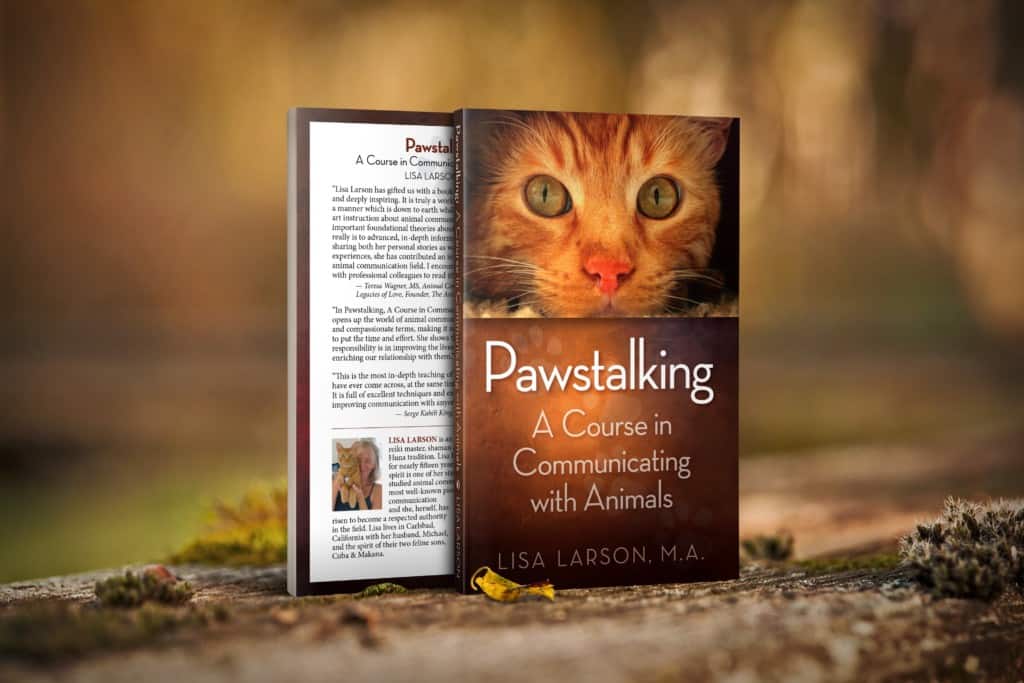
Alternative forms of health and healing are becoming increasingly popular for humans and their companion animals. Canine massage, acupuncture, animal communication and Reiki are just a few ways in which we are creating happier and healthier lives for ourselves and our pets. In this feature we had the pleasure of hearing from Lisa Larson from Pawstalk Animal Communication & Reiki. Lisa is an animal communicator/psychic medium, ordained Huna Alaka’i/shaman, author and Reiki master.
Could you tell us a bit about your background and how you started your journey in working with animals?
In 2004 we needed to help my cat, Cairo, cross into spirit. I had done tarot and psychic work all my life, and I heard about animal communication, we even had thought about contacting one to speak to our two cats, but like so many people, we didn’t know who to call or who to trust.
In the course of our decision to “lift Cairo up” (rather than “put him down”) I called the woman who helped us rescue him to tell her. It was she who sent over a wonderful communicator who gave us such comfort in the process. I was struck with the feeling of, “If I could do for others what she did for us, that would be the greatest feeling in the world.” It is.
When the communicator found out of my psychic experience, she said, “If you can do that, you can do this.” So, I took classes, practiced, & when I lost my college teaching job in the recession, people just started calling me to talk to their animals. So it was, Pawstalk was born.
How would you describe how you connect with animals?
I connect with animals through telepathy and energy. Because these are animals’ main modes of communication, I’m able to connect with them distantly, so I work with animals all around the country, & all over the world.
In using these techniques, I see, hear, & feel things that the animal is communicating to me. The images are similar to what we experience when we are just about to fall off to sleep. The sounds I hear sound like my own thoughts. The feeling part can be both emotional or physical. I might feel a sensation in my arm or leg, or just get a sense of happiness or sadness. Other times, it’s a sensation of just knowing something (called claircognizance).
The difference is, I’ve trained myself to empty my mind completely when communicating so that when I see, hear or feel something, I know it’s coming from the animal, not from me.
More than anything, though, it’s connecting with the animal’s energy, & being on the same wavelength as they are. In that way, I not only feel them, but they feel and trust me. What I love most is when animals who I work with repeatedly, even having never met them in person, are happy to see me when I connect.
What are the more popular aspects that your clients seek guidance on?
One of my specialities, my favorite specialty, is that of speaking to animals in spirit. It’s truly gratifying giving those in grief the peace and comfort of connecting with their fur loved ones who have shed their physical clothing and who now reside in spirit. It lets them know that they are happy and at peace. Because of that forté, I have a lot of clients looking to talk to their animals who have transitioned to the spirit world. (And humans, for that matter, as I am also a psychic medium.)
Other popular reasons people call me are behavioral or emotional problems such as inappropriate elimination, anxiety, aggression, grief, etc. I also have clients, many of them repeat, who call me to let their animals know their people are going on vacation, and how they will be taken care of; to prepare animals for a move or some sort of change in their lives; and/or dealing with an animal’s illness. For example, seeing how they are feeling, explaining to them why they need to go to the vet, or take medication, and in some cases, preparing them for their own transition. (Much of which is also preparing the person, even though they don’t realize that is why they are calling.)
Reiki is a Japanese word that literally translates to “universal life energy”. Please tell us how you incorporate this ancient healing art in your practice with animals and the benefits that can be experienced.
For the most part, I keep my healing sessions and communication sessions separate, so I can focus on each completely. That said, I often will give a ‘pop’ of reiki to an animal I’m communicating with if I feel they are anxious, or if I feel it will help them comfortably connect with my energy so they will trust and be more open with me.
As for my independent healing sessions, there are are several benefits to my clients but I want to stress that there is a huge difference between my healing sessions & the healing sessions of practitioners who primarily practice Reiki.
Reiki is arguably the most well-known form of energy healing, but there are many different healing modalities. For myself, I am also a shamanic healer in the Huna (Hawaiian Shamanism) tradition. So, when I perform a healing session, I initially start with reiki and pepper it throughout, but I also use several Huna healing techniques, as well as “Dreamhealing” techniques I learned from an amazing Canadian healer.
Most often, I use the same techniques in the same order, always starting with reiki, but once I get into the session I make an assessment, based on the energy of the animal, as to which techniques will be most effective for them, and I add and/or change techniques as needed, depending on each animals’ specific situation and energy that day.
After the session, I email the animal’s person to tell them which techniques I used and what the energy felt like.
Is there anything that you would tell pet owners not to do when communicating with their pet?
First of all, I never use the word “owner.” For me, it connotes that an animal is nothing more than ‘property’ which, in most states, is the legal definition. I am one of those crusaders who believes that laws should be changed to protect animals as the living, breathing, sentient beings that they are. To me we are their guardian, or pet parent, or simply “mom” or “dad”. 🙂
In that understanding, one suggestion I have for people is to talk to their animals as they would talk to any human family member. Animals may not understand every word of English we speak, but we speak words with intent, and they understand intent. So I suggest that people talk to their animals for reasons including but not limited to:
- Don’t say critical things about them in front of them. None of us like being called ‘fat’ or ‘old’. So if you would’t say it in front of a person, don’t say it in front of an animal. Furthermore animals take on the things we say about them. One woman kept calling her cat “old”. The cat was only 12! I suggested she stop calling him that. I got a note from her a week or so later saying that was the only thing she changed and she had a whole new, exuberant cat on her hands! They hear. They listen. They comply.
- Tell them where you’re going and when you’ll be back. Just as you wouldn’t just leave the house without telling a human family member, be mindful of your animal, as well. At the very least, humans may conceptualize, “Oh, I know she had shopping to do.” But animals, especially those with abandonment issues, wake up and think, “Oh my God! She’s never coming back!”
- Tell your animals when something will happen, like having to go to the vet; move out of their home, or when someone, human or animal, is coming to live with you. Better yet, ASK them how they feel in explaining why you need to do what you are doing.
Just remember, animals are members of the family. Talk to them and treat them as such.
Lastly, do you have any resources available for people to learn more on how to communicate with animals?
I believe in three methods, all working together, to learn to communicate with animals: Books, Classes, & Practice.
Books give a comprehensive insight into different methods from different communicators, and give the reader a chance to absorb the information.
Classes (with the right teacher) give a sense of structure and feedback so that people can work through their challenges and obstacles with an experienced communicator. A good teacher also helps one understand not only how to receive the information, but how to present the information in a way the client can accept.
The most important thing to remember about animal communication is, the information itself is useless if you are not able to present that information in a way the client can truly understand and accept without bristling. Because often the information ends up being about them.
A good communicator, also, has to have done work on themselves, have confidence without ego taking over, and be socially adept in interacting with humans, as well as animals.
Practice is paramount. Without practice, a communicator doesn’t really understand how to navigate between clients and the information they receive.
Unfortunately, there are too many people who take one class and then hang up a shingle. The problem with that is the damage they can do to both the animal and the human. Practice, a lot of it, is key to becoming a good animal communicator.
I, of course, recommend my book, “Pawstalking: A Course in Communicating with Animals” to start with. I also teach yearly classes, do tutoring and mentoring, and, hopefully, will soon have video-on-demand classes available.




